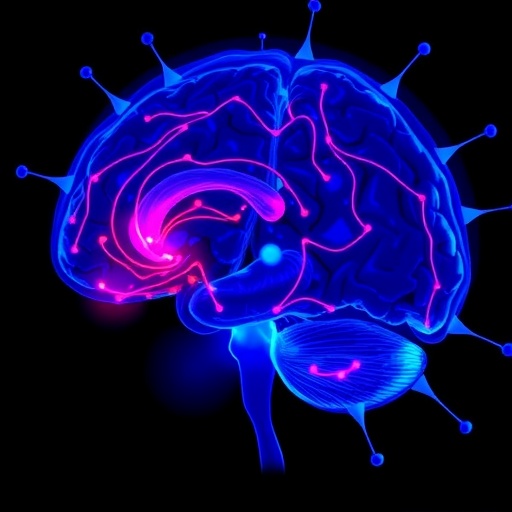
In the relentless pursuit of innovative therapies against glioblastoma, one of the most aggressive and lethal brain tumors, a groundbreaking study has emerged that holds promise for transforming local immunotherapy approaches. The research, recently published in Nature Communications, unveils a novel strategy that significantly mitigates the toxicity commonly associated with interleukin-12 (IL-12) therapy while enhancing therapeutic efficacy. By leveraging the silencing of the neonatal Fc receptor (FcRn) within the IL-12Fc fusion protein construct, the team led by Beffinger, Schellhammer, Taskoparan, and colleagues provides compelling evidence that this molecular modification can profoundly improve survival outcomes in experimental glioblastoma models.
Glioblastoma, characterized by rapid growth and remarkable resistance to conventional treatments, has historically posed formidable challenges for clinicians and researchers alike. Immunotherapy, which stimulates the patient’s own immune system to target tumor cells, has emerged as a beacon of hope. IL-12, a potent pro-inflammatory cytokine, is pivotal in orchestrating anti-tumor immunity, inducing the activation of natural killer (NK) cells and cytotoxic T lymphocytes. However, the clinical utility of IL-12 has been severely constrained by its systemic toxicity when administered freely or in local contexts, often resulting in severe adverse effects that preclude dose escalation.
The innovative approach detailed in this study centers on modifying IL-12 as a fusion protein linked to the Fc fragment—a component of immunoglobulin G (IgG)—which typically confers stability and extends circulating half-life. Crucially, the authors manipulated the interaction between this Fc portion and FcRn, the cellular receptor responsible for IgG recycling and salvage. FcRn generally binds to the Fc region at acidic pH in endosomes, preventing lysosomal degradation and recycling IgG back to the cell surface for release. This receptor-mediated process extends serum half-life of therapeutic antibodies but can also inadvertently facilitate systemic dissemination and accumulation, potentially exacerbating toxicity.
By “silencing” FcRn binding in the IL-12Fc fusion protein, Beffinger and colleagues engineered a version of IL-12Fc that evades the usual FcRn salvage pathway. This molecular redesign curtails the systemic exposure of IL-12 by promoting its local retention and more rapid clearance from circulation, thereby diminishing the systemic cytokine storm and toxicity typically elicited by IL-12 therapy. This nuanced understanding and strategic interruption of FcRn dynamics represent a masterstroke in cytokine engineering, bridging immunology and molecular pharmacology in a manner not previously appreciated.
Experimentally, the therapeutic impact of FcRn-silenced IL-12Fc was assessed in rigorous murine glioblastoma models. Localized administration of this modified cytokine elicited potent anti-tumor immune responses within the brain tumor microenvironment. Immune profiling revealed a robust expansion of effector T cells and NK cells, hallmarks of IL-12’s immunostimulatory capacity, while markers of systemic inflammation and organ toxicity plummeted compared to non-silenced IL-12Fc treatment groups. This dual outcome underscores the ability of FcRn-silencing to dissociate therapeutic benefit from collateral damage—a vital advance towards clinical translation.
Importantly, these promising immunological effects translated into meaningful improvements in survival. Mice receiving the FcRn-silenced IL-12Fc displayed prolonged tumor control and extended lifespan relative to control cohorts. The data suggest that preventing FcRn interaction optimizes the balance between effective local immune activation and systemic safety, overcoming a longstanding hurdle in cytokine therapy development. This balance is particularly crucial in brain malignancies, where systemic toxicities can be devastating, and the blood-brain barrier imposes additional therapeutic challenges.
The molecular mechanisms at play extend beyond simple pharmacokinetics. Silencing FcRn modifies the intracellular trafficking and degradation pathways of the IL-12Fc molecule. By reducing recycling and increasing lysosomal degradation, the cytokine’s persistence in systemic circulation is minimized, limiting exposure to off-target tissues and immune compartments. This finesse in molecular trafficking modulates not only pharmacodynamics but also the therapeutic window, allowing higher effective doses to reach the tumor microenvironment without breaching safety thresholds.
This study also informs a broader conceptual framework for therapeutic protein engineering. Fc-fusion proteins have long been utilized to improve stability and half-life, but indiscriminately extending systemic circulation may in some scenarios be counterproductive when dealing with potent biologics like cytokines. The precise tuning of Fc-FcRn interactions opens new avenues to harness Fc-fusion advantages while fine-tuning biodistribution and minimizing toxicity. This principle could conceivably be extrapolated to other therapeutic areas involving cytokines, antibodies, or fusion proteins requiring a balance between efficacy and safety.
Within the context of glioblastoma immunotherapy, this work carries profound implications. The immunosuppressive nature of the glioblastoma microenvironment has been a major impediment to successful immunotherapy, as it blunts immune cell infiltration and activation. Strategies that induce robust local immune activation without triggering systemic inflammatory cascades are desperately needed. The FcRn-silenced IL-12Fc therapy represents a sophisticated means to locally amplify anti-tumor immunity while safeguarding patients from cytokine-associated toxicities that have historically stymied IL-12 clinical progress.
Moreover, the methodology and findings pave the way for combining FcRn-silenced IL-12Fc with other immunotherapeutic modalities. Checkpoint inhibitors, CAR T cells, and oncolytic viruses are all under intense investigation for glioblastoma, and the ability to integrate a safer, more effective IL-12 variant could synergistically enhance outcomes. By ensuring local cytokine activity with minimal systemic spillover, this approach may mitigate the overlapping toxicities often encountered in combinatorial regimens, potentially enabling more aggressive and durable therapeutic strategies.
Another intriguing facet arises from the intracellular routing modulated by FcRn interaction. FcRn is expressed not only in endothelial cells but also in antigen-presenting cells such as dendritic cells and macrophages. The altered trafficking dynamics of IL-12Fc could influence antigen presentation and immune priming in ways that transcend simple cytokine availability, potentially reshaping immune cell crosstalk within the tumor microenvironment. These mechanistic nuances merit deeper exploration, but the initial data hint at a rich interplay of molecular immunology that could be exploited for maximal therapeutic gain.
The results also underscore the importance of translational research models. Preclinical glioblastoma models incorporating humanized cytokine and Fc receptor systems are pivotal in elucidating human-relevant signaling and immune dynamics. The careful engineering and rigorous in vivo evaluation presented in this study exemplify the kind of molecular and translational rigor required to bring next-generation immunotherapies from bench to bedside effectively.
In sum, the study conducted by Beffinger, Schellhammer, Taskoparan, and colleagues embodies a paradigm shift in how cytokine therapies can be rationally designed to maximize local efficacy and minimize systemic risk. By silencing FcRn interactions within IL-12Fc fusion proteins, they have crafted a sophisticated immunotherapeutic agent that not only bypasses the classical toxicities of IL-12 therapy but also substantially prolongs survival in robust glioblastoma models. This work delivers a compelling blueprint for the future of cytokine-based immunotherapy, blending molecular engineering with immunological insight to tackle one of oncology’s most formidable adversaries.
As glioblastoma continues to challenge conventional treatment paradigms, innovations such as this offer renewed optimism. The capacity to finely tune immune stimulatory molecules in situ, protecting patients from systemic side effects while unleashing potent local immune assaults, could transform the therapeutic landscape. This research highlights that overcoming biological delivery barriers and immune-related toxicities requires not only novel agents but also a deep understanding of molecular immunology and receptor biology.
The potential impact of this work is far-reaching, heralding a new chapter in immune modulation for brain tumors and beyond. Future clinical investigations will be critical to validate safety and efficacy in humans and to explore combinational approaches. Yet, even at this early stage, FcRn-silenced IL-12Fc emerges as a beacon of hope for patients and clinicians confronting the devastating prognosis of glioblastoma. This landmark study exemplifies the fusion of molecular biology, immunology, and translational science necessary to unlock the next generation of cancer immunotherapies.
Subject of Research: FcRn-silencing in IL-12Fc fusion protein to reduce toxicity and enhance local immunotherapy efficacy in glioblastoma.
Article Title: FcRn-silencing of IL-12Fc prevents toxicity of local IL-12 therapy and prolongs survival in experimental glioblastoma.
Article References:
Beffinger, M., Schellhammer, L., Taskoparan, B. et al. FcRn-silencing of IL-12Fc prevents toxicity of local IL-12 therapy and prolongs survival in experimental glioblastoma. Nat Commun 16, 4751 (2025). https://doi.org/10.1038/s41467-025-59971-0
Image Credits: AI Generated
Tags: challenges in glioblastoma treatmentcytokine therapy and tumor immunityenhancing therapeutic efficacy in glioblastomaFcRn silencing in glioblastoma therapyIL-12 immunotherapy for brain tumorsinnovative strategies for glioblastoma treatmentlocal immunotherapy approaches for brain cancerneonatal Fc receptor role in cancer therapyovercoming glioblastoma resistance to treatmentpro-inflammatory cytokines in cancer therapyreducing toxicity of IL-12 treatmentsurvival outcomes in glioblastoma models



